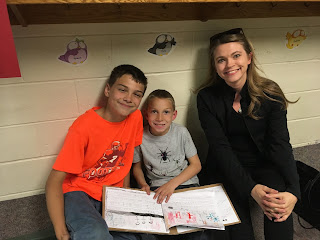That's right....EVERY kindergarten through grade 5 student wrote, edited, illustrated, and published a cardboard book. (A cartonera is a book with a cardboard cover. You can find more information about them in this video.)
It was quite an accomplishment, to say the least!
Last Thursday was the day the entire school took a break from what we were doing and for one hour, we read and commented on each other's cartoneras. Students met up with their character ed buddy and walked around together, stopping often to read a cartonera together.
Even the teachers got in on the fun.
After reading a cartonera, the reader left a compliment on the Raves From Readers page.
The students could hardly wait to get back to their classroom to read their Raves From Readers comments. They were incredibly empowering and demonstrated the effect of writing for an authentic audience.
Then in the evening, we invited families to school to read the cartoneras and to make a family cartonera to take home to write their family story.
We also had Paloma Celis Carbajal, a bibliographer and cartonera expert from the University of Wisconsin - Madison visit us. She brought with a few of the cartoneras from the UW collection, the largest collection of cartoneras in the United States, for our kids to check out.
Here's what some of my students had to say about the Cartonera Project:
"When the books were published, I felt accomplished."
"It was fun to walk around with my buddy to read books without my teacher." :)
"It kind of proves that you don't need to be a pro to write a book."
"I enjoyed getting to fix up a story and make it better."
"It was amazing and I thought it was cool. Everyone should do this!"
Isn't that AWESOME??!!?
I am incredibly proud to have been a part of this celebration of writing and sad that the event is over. I am already thinking of ways to grow the program and make it even better, including expanding the project to other schools to connect students and classrooms from around the country in the spirit of writing.
If you are interested in learning more about possibly bringing a Cartonera Project to your school or classroom and would like to learn more, please fill out this Google form. When I get the information together, I will be in touch.




























